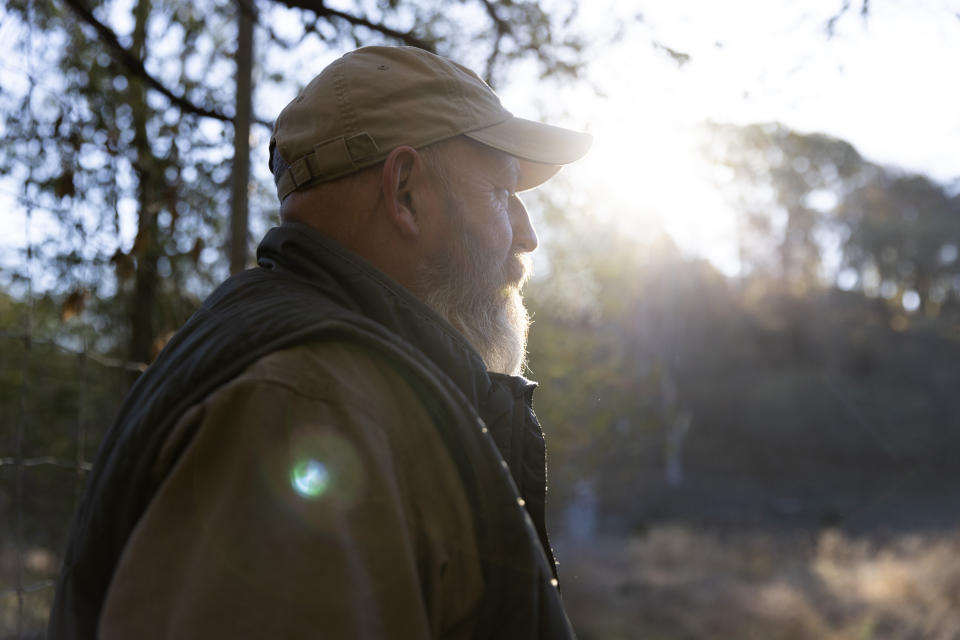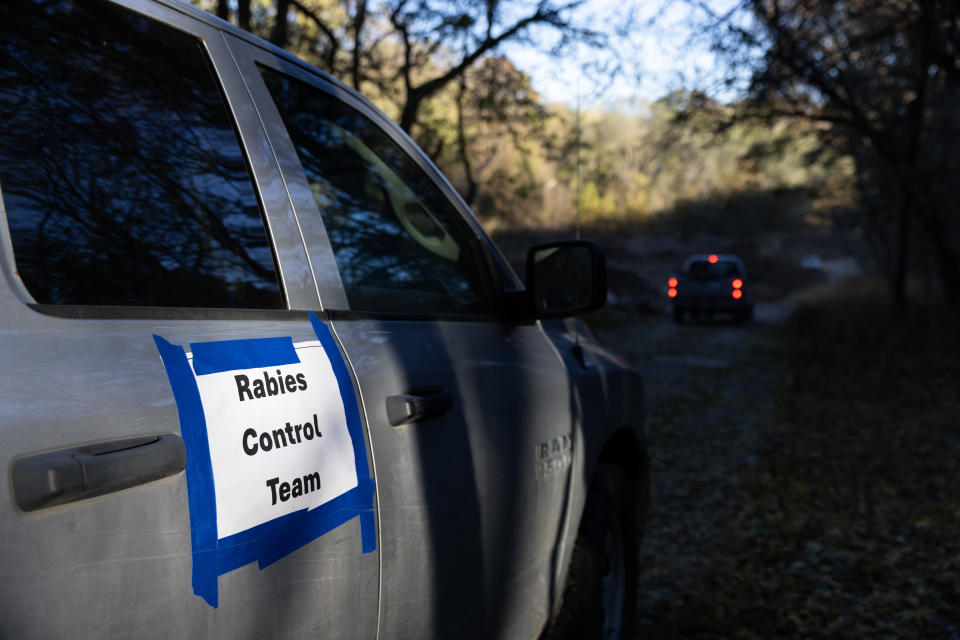How one rabid kitten triggered intensive effort to contain deadly virus
At first, Madeline Wahl thought her new kitten was having a bad reaction to medication for ringworm. After each dose, he would shake his head and flail his legs.
She and her husband, Rich, had brought the kitten to their house in a historic neighborhood in Omaha, Neb., after a friend found the stray meowing in her driveway. About 5 weeks old and barely two pounds, the cuddly black-and-white animal looked like he was wearing a tuxedo. The Wahls named him Stanley.
But, within two days, Stanley stopped eating and developed seizures. Then he stopped breathing; Wahl's husband resuscitated him with chest compressions.
Wahl rushed him to a veterinarian, who noted that the kitten's pupils were different sizes. The vet listed nearly two dozen possible causes, including a common parasitic disease, for the animal's abnormal behavior. Last on her list was rabies, which she assured Wahl was rare in domesticated animals. "We haven't had rabies in forever," Sharon Mix, the vet, said.
The tiny feline died the next day. Test results 48 hours later showed Stanley did, indeed, have rabies. Additional genetic sequencing showed something even more alarming: The kitten had a strain of raccoon rabies that had never been detected west of the Appalachian Mountains. How did it pop up 850 miles from where the variant normally circulates in the eastern United States? And how far had it spread?
"My first thought was, 'It has to be a mistake,'" said Ryan Wallace, who heads the rabies epidemiology team at the Centers for Disease Control and Prevention.
The mystery sparked a broad emergency response showcasing how disease detectives work to figure out the origins of a lethal infection while trying to ensure people don't get sick or die.
The stakes were high. If the virus were able to spread unchecked in raccoons, transmission would easily radiate out from Omaha to surrounding areas, because there aren't many large mountain chains, rivers or deserts in that part of the country to act as natural barriers, Wallace said. The CDC estimates that the virus would expand in concentric circles at about 24 miles a year. Over five years, the rabies strain would make its way to South Dakota, Minnesota, Iowa, Missouri and Kansas, he said, putting an estimated 7 million residents at increased risk.
More than a dozen wildlife biologists drove to Omaha from eight states, as far away as Vermont and New Hampshire, hauling trailers full of traps, injectable rabies vaccine, gallons of anise oil and cases of marshmallows - to lure, trap and vaccinate raccoons in hopes of stopping the deadly virus from spreading. CDC scientists set up labs in trailers to test roadkill for the virus.
Douglas County health officials tracked down 10 people, including the Wahls, their friend and veterinary staffers who had been scratched or bitten by the kitten so that they could receive four doses of rabies vaccine and one dose of human rabies immune globulin to neutralize the virus, treatment that can cost up to $8,000 per person. The officials also posted queries on social media, and volunteers fanned out in neighborhoods to seek information about other sightings of the kitten, possible litter mates, or the mother of the litter.
"We've never had a nine-alarm fire like this," said Richard Chipman, the coordinator of the national rabies program at the U.S. Department of Agriculture.
- - -
Signs of rabies
Rabies is caused by a virus that infects the central nervous system in mammals and is nearly always fatal if untreated. The virus that killed Stanley, the kitten, is transmitted readily among raccoons, animals that frequent backyards, trash cans and farm fields, where they have a greater chance of coming into contact with people.
People in the United States rarely contract rabies - with only one to three cases reported annually - but about 60,000 Americans receive post-exposure treatment each year after being bitten or scratched by infected animals or by animals suspected of being infected, according to the CDC.
More than 90 percent of reported U.S. rabies cases in animals occur in wildlife, most commonly raccoons, skunks, bats and foxes. Animals with rabies may be aggressive and try to bite, or they may be seen to drool more than normal. Others may act timidly or appear to be tame, move slowly, or allow humans to get close - unusual behavior for wild animals that also could be a sign of something wrong. Another sign: different-size pupils.
After Stanley's death, USDA wildlife biologists spent 10 days trapping and vaccinating animals - 753 raccoons, 41 skunks, four feral cats and one red fox - in an area about 61 miles around where the kitten was found. To attract the raccoons - and not other animals that are not reservoirs for the virus - they baited the traps with anise oil, which smells like black licorice, and marshmallows. Raccoons like the smell and taste of marshmallows, which resemble the chicken eggs they like to eat.
USDA, state and local officials also placed 18,000 vaccine packets in parks, along storm drains, around trees and bushes, and near walking paths in the woods in a five-mile radius. The oral rabies vaccine baits come in two-inch sachets similar to a ketchup packet and are coated with fishmeal to attract raccoons.
"As they chew on it, they are bathing their mouth and tonsils with the vaccine, and that starts the immune reaction," Chipman said.
Federal officials have been trying to control the spread of rabies in raccoons using the oral vaccine since 1997. The USDA drops about 10 million doses of oral rabies vaccine a year from planes and helicopters in a band of 16 states stretching from Maine to Ohio and south to Alabama and Texas. The goal is to stop the spread of the raccoon rabies beyond this "hot zone," officials said.
The combined surveillance and vaccination efforts of the CDC, USDA and state health departments have contributed to a 50 percent reduction in the number of rabid raccoons in the United States, Wallace said.
The vaccine distribution program typically reaches about 30 to 40 percent of an area's raccoon population, Chipman said. But Omaha has a large number of raccoons, with density as high as 104 raccoons per square mile in some parts of the city, he said.
- - -
Stopping the spread
Officials won't know until early next year whether they have stopped the virus from spreading. The incubation period of the virus ranges from one week to three months. Stanley was discovered Sept. 26, so if other animals had been bitten or scratched, they might not show symptoms until December.
The ultimate measure of whether the efforts have worked is through the testing of dead animals for the virus. Testing in Omaha is limited by how many dead raccoons animal control, the local humane society and wildlife rehabilitation groups turn over to scientists. On the basis of what officials have seen happen in the East Coast, between 1 and 5 percent of dead animals should be testing positive for rabies if the virus has gained a foothold in the Omaha area. So far, none of the more than 250 dead animals tested have had the virus.
"If we can test [a total] of 500 animals over the next few months through this surveillance program and all are negative, then there is likely no spread in local wildlife," Wallace said. "We won't know for sure until around February."
Officials credit the pet owners' quick action, the astuteness of the veterinarian who recognized the need to have the kitten tested, and the input of a state lab that was recently awarded CDC funding to conduct the genetic sequencing that prompted the emergency response.
It remains unclear how Stanley became infected.
One possibility is that the virus had been spreading undetected in the Omaha area and that a wild animal had bitten and infected the kitten. But a decade of rabies surveillance in states between Ohio and Nebraska had found no rabies cases, according to the CDC.
More likely, officials said, the kitten - or a pregnant cat - was bitten and infected by a raccoon in the southeastern United States, where the virus most closely resembles the genetic fingerprint found in Stanley. Then the kitten or his mother somehow made their way to Omaha.
"Had my husband not resuscitated him," Madeline Wahl said, "we likely would have buried the kitten in our yard and not known about him being rabies positive."
Related Content
How one rabid kitten triggered intensive effort to contain deadly virus
A lovers' tale of romance, fidelity and the aviary netting keeping them apart
The final hours of Rosalynn Carter's life, in the town where it began







